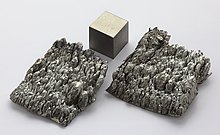 |
| Scandium |
The first time the periodic table expands in size is at scandium, where the large d-block begins. Here, you have five d-orbitals that occupy at least one electron with a maximum capacity of ten electrons. The d-block elements are all transition metals, and as such scandium is the first of these.
Nearly. Completely. Not at all.
Transition elements are defined as those which have partially filled d-orbitals when forming an ion, and a common side effect of this is that transition elements often have various different oxidation states. Essentially, this is how many electrons they can gain or lose to form an ion. Fluorine for example gains one electron to form an ion, whereas sodium loses an electron to do the same. Therefore, the oxidation state of fluorine is -1, and sodium's is +1. Typically the oxidation state of an element is constant, but there are exceptions.
Scandium predominantly has an oxidation state of +3 - scandium oxide, often used in ceramics, has the formula Sc2O3 as a result (scandium's oxidation state of +3 combines with oxygen's oxidation state of -2). Compare that to iron, which can have an oxidation state of +2 (thus forms FeO) or +3 (thus forms Fe2O3), and beyond. Scandium simply doesn't <typically> do anything like this, so it's not a transition metal on this count as well.
This is because of how scandium ions come about. Scandium's position in the periodic table indicates how its electrons are structured by orbital - linearly between s and p orbitals, before an excursion into 4s2 and 3d1, which includes its valence electrons. These are the electrons scandium atoms lose to form a scandium ion since they're of the highest energy levels present in a scandium atom, and since it's at the start of d-block, scandium ions thus have empty d-orbitals - hence the limited oxidation states.
A similar principle applies to zinc, which similarly only usually has a +2 oxidation state, and is thus not a transition metal. However, zinc is at the end of d-block, Period 4, and thus its valence electrons are 4s2 and 3d10 - the s orbitals are emptied first to form a zinc ion. Zinc thus has full d-orbitals, so its oxidation state is limited and also isn't transitional.
Except...there can be exceptions. What if we pushed zinc to the limits and forced it to form a +3 oxidation state? Mercury, which is in the same group as zinc, had this happen in 1976, when a +3 oxidation state was found, and eventually a +4 state - by 2007, we had mercury fluoride (HgF4)! Except zinc has a higher third ionisation energy than mercury, nearly 5eV worth, which thus makes it more difficult. However, following lots of complex calculations and chemistry, should zinc be allowed to interact with super-electrophilic trianionic ligands (very electrophilic ions with a 3- charge), it should theoretically have a +3 oxidation state. BeB11(CN)123−, come on down; you've won a prize for defying A Level chemistry.
Scandium meanwhile is slightly more straightforward as a compound already exists where scandium has a +2 oxidation state, bonded with caesium and chlorine in CsScCl3, which looks weird when written out. The problem is that caesium is radioactive, unstable, and highly reactive, so you're not likely to ever obtain such a compound. However, we've managed to defy A Level chemistry again - scandium and zinc are transition elements, albeit in extreme and rare circumstances.
Perhaps every element is transition element-esque, if we try hard enough. Hydrogen (+1 and -1), oxygen (-1 and -2) and chlorine (-1 and +5) are already notorious for having various different oxidation states. One paper states there's a negatively charged sodium ion amongst various other alkalides, and even helium sometimes forms compounds. Yet fluorine is an exception to this unusual idea. A positively charged fluorine ion has never been identified, and since it's so electronegative, will probably never be identified either. But hey, at least we've found two potential exceptions.
Epilogue and additional notes:
My chemistry teacher often drills zinc's rigid oxidation state into our minds, making us write it out in the rare test, though this has never been the case with scandium. I suppose it could partially be because scandium can achieve different oxidation states more easily than zinc can, at least there are compounds which are present that suggest so; maybe you're simply more likely to encounter zinc. Either way, as is often the case in science, every rule has an exception - unless that rule is fluorine.
Though it's worth noting that a negatively charged sodium ion, as well as a Zn3+ ion, are very unlikely to occur in everyday situations. However, theoretically they could.
A Problem with Scandium - a blogpost which discusses this issue well.
Comments
Post a Comment